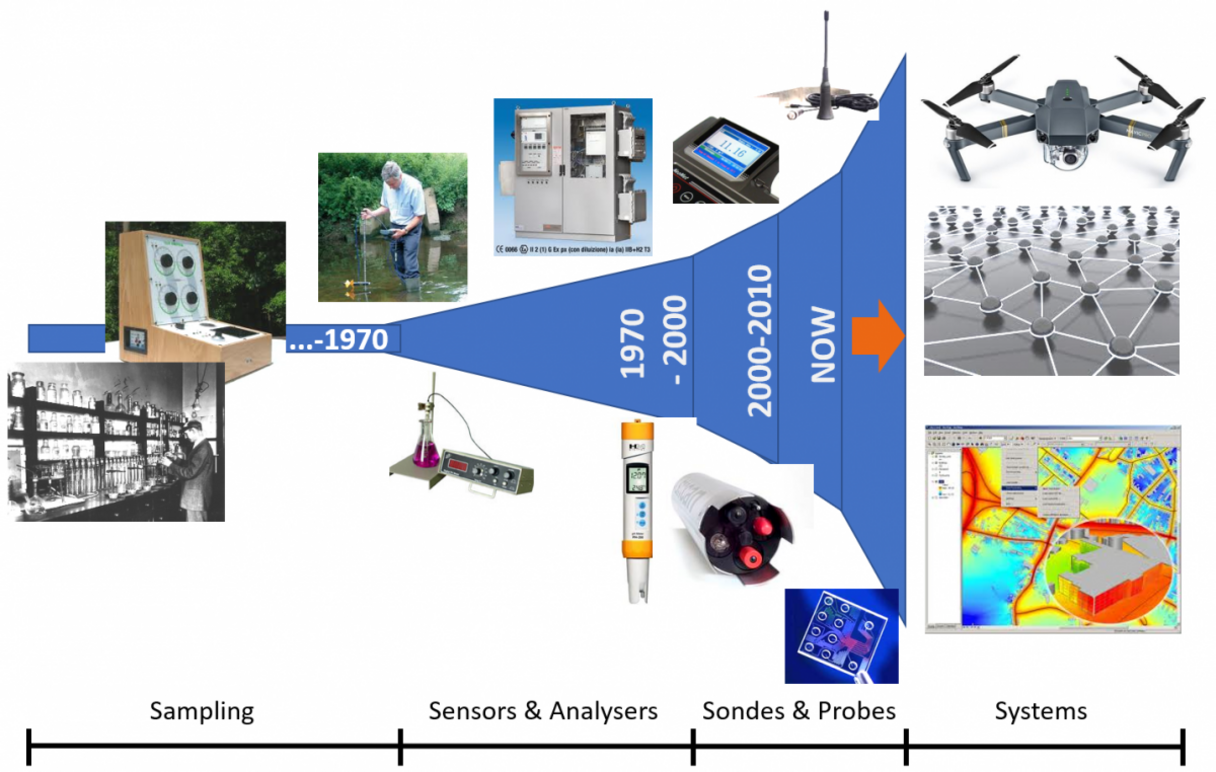Blog
At the beginning of this month, we commemorated the end of the Second World War, now 75 years ago. This caused me to look back on the history of water quality monitoring, especially since the end of the Second World War, when a long period of reconstruction began. Water quality problems had occurred well before the two world wars, and in fact date back as far as the early days of the industrial revolution, around 1800. Before the wars, water pollution concerns were mainly related to pathogens such as cholera and typhoid, waterborne diseases that were widespread in densely packed cities where many people used the same (contaminated) water source. Water treatment thus focused on eliminating such pathogens by means of filtration and chlorine disinfection.
Shift in focus from biological to chemical pollution
After the Second World War, the Chemical Revolution came into full swing and led to the production of thousands of synthetic chemical substances, which also found their way into the water environment through (unregulated) industrial discharges and accidents. The focus on microbial water safety caused governments to largely ignore the consequences of chemical pollutants in water for a long time. In the early nineteen sixties, a connection was made between these synthetic organic chemicals and cancer as well as other public health issues, but it took until the nineteen seventies for regulators to include chemical parameters in water regulations. Water treatment technologies also shifted focus to include active carbon treatment methods to remove chemical substances from drinking water.
Development of monitoring technologies
Since the late sixties, water monitoring experts have been engaged in an arms race with the industrial sector to determine the effects of discharges of a wide variety of chemicals into the environment, and to feed regulatory bodies with the necessary information to adequately protect public health. Initially water monitoring efforts were concentrated in laboratories, and they largely reflected the developments in water pollution as described above. For example, the first HPLC-system for monitoring chemical substances was commercialised in 1969. But from the early seventies onwards, more and more field monitoring equipment was developed to monitor water pollution directly on-site. These developments were not only incentivised by the occurrence of certain pollution types in the water environment, but to a large extent also boosted by some technological developments, which at first sight did not seem to have anything to do with water monitoring at all.
Technology push for electrochemical and optical sensors
The history of electrochemical sensors started with the development of the glass electrode in 1906. Over many years, electrochemical sensors have evolved into low-cost, miniaturisable instruments with a rapid response, superior sensitivity and selectivity. Detection limits have improved to match the necessary measuring range for effective environmental and drinking water monitoring.
Optical sensor technology was boosted tremendously by the development of the first laser in 1960. Since then, optical sensors have seen a huge development into reliable and stable instruments for monitoring a wide variety of parameters. Although more expensive than most electrochemical sensors, optical sensors generally show less drift in signal, thus reducing the necessary amount (and costs) of maintenance related to recalibrations considerably.
But aside from these developments which directly supported the detection and identification of water pollutants, several other technology developments have boosted the application potential of these sensors in the past 30 years:
- Since the mid-nineties computer power has increased significantly, enabling the analysis of larger datasets.
- Halfway through the first decade of 2000, wireless communication protocols became available, and allowed for sensor technologies to be applied at a much wider range of locations, such as pumping stations without regular staff presence. Communication was thus no longer one-way traffic of the sensor sending its monitoring data, but became two-way traffic through which the operator could adjust sensor operations remotely.
- In recent years, remote power supplies have become more and more affordable (e.g. the price of solar cells has dropped drastically), allowing for the placement/deployment of sensor technologies at locations where no grid-power is available. Additionally, more and more sophisticated (big) data analysis tools are becoming available, so that multi-parameter monitoring data of high spatial-temporal resolution can be collected and processed into meaningful information on which management decisions can be based. The further development of drone technologies also promotes the application possibilities of sensor technologies for water quality monitoring directly under water or from the air.
The example of nitrate
The current landscape of available sensor technologies for measuring a broad range of water quality parameters clearly reflects both the global water pollution history and major technological developments over the past 100 years, as can be illustrated by the parameter nitrate. In 1958, WHO included nitrate in its International Standards for Drinking Water, thereby specifically mentioning the risk of elevated nitrate levels (50-100 mg/L) causing methemoglobinemia in infants under one year of age. Since then, various field methods for monitoring nitrates in water have become available, such as ion-selective electrodes (ISEs; available since the nineteen seventies), wet-chemical analysers (since the nineteen eighties) and optical sensors (since the early 2000s).
Find out more about sensor technologies currently available
In order to obtain a better insight into the current landscape of electrochemical, optical and other types of sensors as well as analysers (based on conventional laboratory methods), Sensileau has analysed over 1,500 online water monitoring product-types of approximately 300 manufacturers worldwide, covering 85 different water quality parameters. Curious to see what the online water monitoring landscape looks like today? Sign up for the Sensileau Sensor Platform and check out our sensor database containing a complete overview of commercially available sensors and monitors for the water industry.

